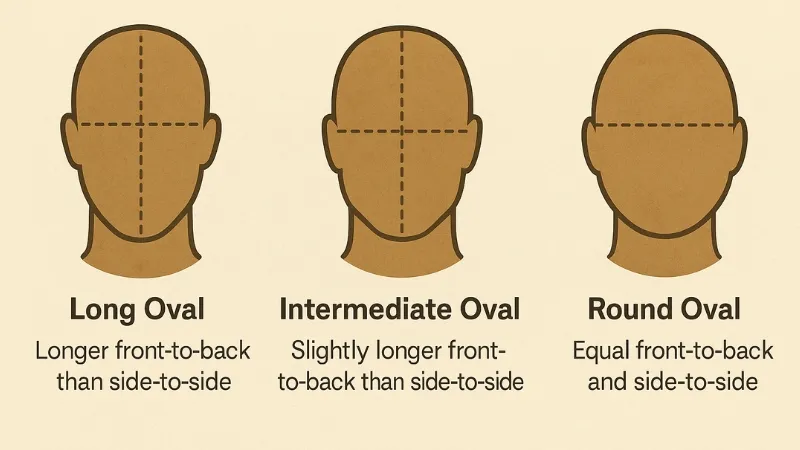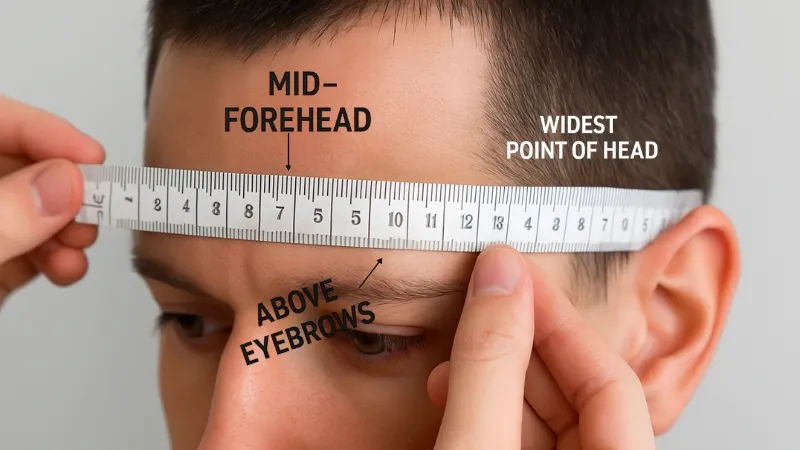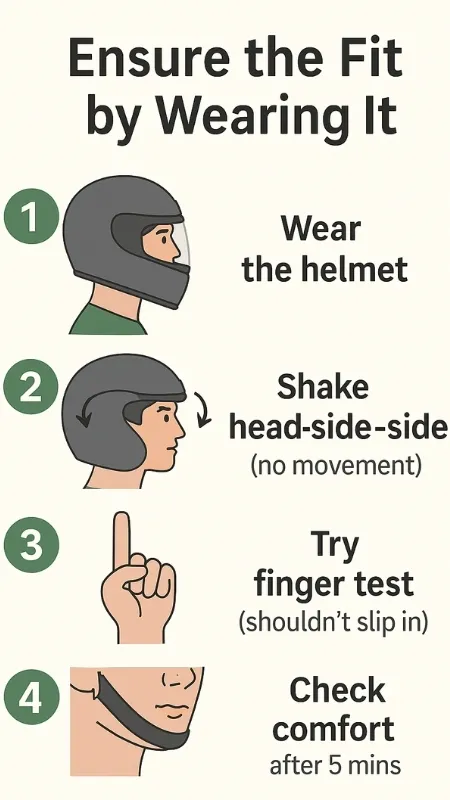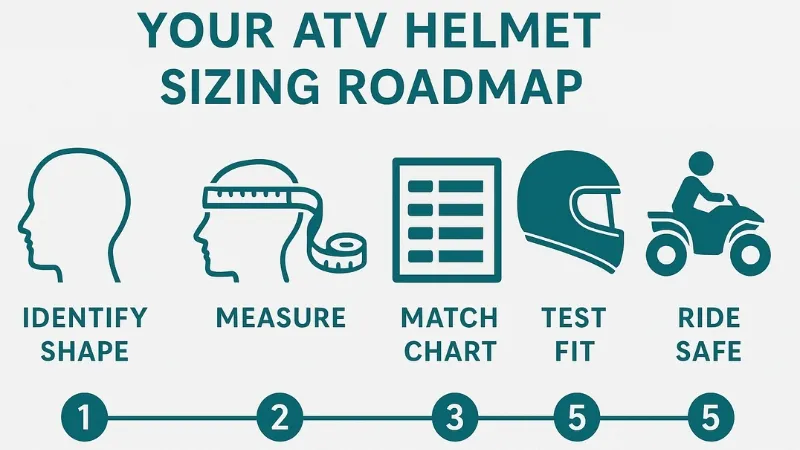Choosing the right ATV helmet size isn’t just about comfort—it’s about safety. Even the most advanced helmet can fail to protect if it doesn’t fit your head properly.
Getting the perfect fit begins with understanding your head’s shape and size. These two factors determine how well your helmet stays secure while you ride through challenging terrain.
In this guide, you’ll learn how to measure your head accurately, interpret manufacturer charts, and test for the ideal fit. Follow these steps to ensure every off-road adventure starts with confidence and protection
Recommended Read: Top 10 ATV Helmets at Your Budget
Jump To Contents
Measure ATV helmet flawlessly in 5 Steps
Knowing the correct ATV helmet size might be a tall order. However, you can take head measurements as one of the crucial steps of choosing an ATV helmet. This way, you will know whether you need to purchase a large, small or medium helmet matching your head size and shape. Here go:
1. Know the shape of your head
Before you get started, know the shape of your head. Fortunately, manufacturers usually consider this whenever they are designing various helmets for sale. In most cases, most ATV helmets are available in 3 main shapes. These include:

Long oval
Such a head is usually longer from the front to the back than side to side. A long oval helmet is usually 0.5 inches longer than an intermediate oval.
Intermediate oval
The above-mentioned head shape is generally circular in shape but has a wide side-to-side measurement shorter than the front-to-back measurement. To take these measurements, you have to start taking them from the forehead to the largest area located at the back of your head’s skull.
Round oval
Compared to the intermediate oval shape, this head shape usually has a longer side-to-side measurement than the front-to-back measurement.
With the head shape recognized, you now measure your head circumference.
2. Take the measurements of your head

After determining the shape of your head, the next step is to measure its size. When measuring your head’s size, place the tape measure at the middle of your forehead. Ideally, the tape measure should rest slightly above your eyebrows.
Thereafter, wrap it around the middle of your head. For sure, this one is the thickest part of your head. For optimal results, wrap it all the way, such that it goes above the occipital bone. Let the tape measure go all the way to the point of the forehead where you start taking the head measurements from.
When wrapping the head with the tape measure, ensure that the tape measure is not too tight. Instead, it should be snug for accuracy and a comfortable helmet fit.
Once you are done, read the measurements and then record them somewhere. Better to take help from a family member or friend so that you can take precise head measurements.
Tip: Reminder, what you have got as a head circumference, the head size for the helmet would be one inch bigger than that. Say, your head circumference is 19”, and so your helmet size should be 20”.
With your measurements in hand, it’s time to put them to use—compare your numbers against the manufacturer’s size chart.
3. Compare with the manufacturer’s size chart
For you to choose the correct ATV helmet size, now compare your head measurements (determined following the above guideline) with those presented on the manufacturer’s size chart. Remember that the manufacturer normally offers their measurement chart based on the ATV helmet design.
The following is a chart to use as an example for you to determine the right adult ATV helmet to invest in:
Adult ATV Helmet Size Chart
| Helmet size | Inches | Centimeters | Age |
| Extra small | 20.5 -21.5 | 52-54.6 | 14 |
| Small | 21.5-22.5 | 54.6-57 | |
| Medium | 22-23 | 55.9-58.4 | |
| Large | 23-24 | 58.4-61 | |
| Extra large | 24-25 | 62.2-63.5 |
If you want to get an ATV helmet for your younger siblings or kids, here is an example chart that can help you choose the best model:
Kids/Youth Helmet Size Chart
| Helmet Size | Circumference (Inches) | Circumference (CM) | Age |
| S | 17.5-18.9 | 47-48 | 3 Years |
| M | 19.3-19.7 | 49-50 | 3-5 Years |
| L | 20.1-20.5 | 51-52 | 5-8 Years |
| XL | 21-22 | 53-55 | 8-13 |
It is imperative to note that the above-mentioned measurements are just average sizes for ATV helmets. With this child ATV helmet size chart, you will have a good idea of the size available there. You can go through other guides on helmet size for clearer ideas.
Be careful when selecting a helmet for youth. Any youth helmet size chart will tell you that there are small, medium, large, and extra large sizes for youth ATV helmets. An interesting fact is that youth ATV helmet size has several sub-categories based on head size.
And when searching for a youth helmet, you have to go by the youth ATV helmet size chart by age. – starting from 3 years and ending at 13 years. Interestingly, 14 is the adult age when it comes to ATV helmet size.
If your head is smaller than the extra small size, consider going for the smaller than extra small size. Such a head is usually below 20.5 inches. On the other hand, if your head is larger than the extra-large size, consider getting the larger-than-extra size helmet, whose head circumference is beyond 25 inches.
Recommended Read: Why Do ATV Helmets Have Peaks?
4. Finalize the Size
It is no news now that helmet size charts are brand-specific, and so no helmet size chart is universal. But the established size range for adult helmets is 20-21” and those of the Kids-youngsters’ – 17.5-20”.
What I mean by finalizing the helmet size is that you’d better go for 1 size smaller as the helmet, featuring with inner lining cushion, will go a bit loose after the breaking-in period. When choosing the kids helmet, you can go by1 size smaller than the snug fit, as the head will fit in comfortably after the inner cushion and layer stretched in.
But considering the scenario that kids’ heads outgrow the helmet size pretty quickly, going by the same size as head circumference will not affect the fit significantly.
After matching your head size to the chart, refine your choice by considering how helmets fit over time.
5. Ensure the Fit by wearing it

Yes, you can develop a clear impression of the size category, and you may find the helmet of your fit from the manufacturer’s size chart. But to reach the desired snug fit, the flawless method is to try the helmet and feel how it feels.
Take a helmet matching the size and shape of your head from the store and wear it. If it is painfully tight, this is not your cup of tea.
On the contrary, if the helmet moves with your head movements and you feel it comfortable, it is a good fit. But if the helmet stays as it is while turning your head, it is too loose and will fall off your head in case of an accident.
Another trick to finding a loose helmet is to try to let your finger slip in. If the finger slips in easily between your forehead and the helmet’s front end above your eyebrows, this is a loose helmet to avoid.
To check whether a helmet is too tight or snug, keep it worn for a certain period. If you feel any over-stressed spot across your face and head, it is bitingly tight, not snug.
A comfortably fit helmet will not glide with your head movement, nor will it cause your cheek, forehead, and chin to feel sore or any pressure points.
Even with the perfect size, a few expert tips and precautions can make your helmet experience safer and more comfortable.
Read: How Do You Put On an ATV Helmet Without Feeling Like a Newbie?
How do I tell if my ATV helmet fits well?
If your preferred ATV helmet is a little bit tight on your head without essentially making you feel uncomfortable, be sure that it fits well. Ideally, your ATV helmet of choice should not move whenever you try to shake your head. To tell if your helmet is well fitted, ensure the four things below:
- Adjust your chin strap and now pull on the helmet. Move your head side by side and watch out for Play. A safe and comfortable fit helmet will have no play.
- Another test is to grab the helmet to see if it goes upward at pulled. It passes the test if you are unable to lift it.
- The easy and popular test is to try to slip a finger in between the helmet front and forehead. If it doesn’t slip in, it’s okay.
- Put on the helmet and leave it as it is for a few minutes. If you feel pressure points and spots across the chest worsen over time, it is too tight to give a safe fit.
Expert Tips for Measuring the Perfect ATV Helmet Size
If you’re a beginner in ATV riding, finding the correct helmet size can feel confusing at first. Here are some expert-backed tips to help you measure and choose the right ATV helmet for a perfect fit.
How to Measure Your Head for an ATV Helmet
- Use a flexible measuring tape to take the circumference of your head. For better accuracy, have someone assist you while you keep the tape about one inch above your eyebrows.
- Write down your head measurement in centimeters or inches and compare it with the helmet size chart from your chosen brand. Each manufacturer may have slight variations in sizing.
Compare and Test Different Helmet Brands
- Try on helmets from at least three different manufacturers to find which fits your head shape most comfortably.
- Helmet sizing and fit principles are similar across ATV, motorcycle, and snowmobile helmets, so you can use your experience across different vehicle types.
Perform a Real Ride Test
- Even if a helmet feels perfect in-store, it might feel different while riding. Take your helmet for a short ATV ride to test comfort, stability, and noise resistance before committing.
Important Precautions When Choosing an ATV Helmet
Once you’ve measured your head and selected a few helmet models, it’s time to ensure that the fit, safety, and comfort align perfectly. Follow these safety precautions before purchasing.
Ensure Proper Fit and Visibility
- The eye port should sit just above your eyebrows, giving you a wide peripheral view.
- The helmet inseam should rest within one inch above your eyebrows and fit snugly all around your head.
Check for Essential Features
- Look for helmets with a detachable visor and adjustable cheek pads for personalized comfort.
- Always consult the manufacturer’s official size guide to confirm your correct fit before buying.
Mind the Chin Strap Fit
- A properly fitted helmet won’t allow even a single finger between the liner and your head.
- However, the chin strap should permit up to two fingers underneath—tight enough to be secure but not restrictive.
Avoid Oversized Helmets for Kids
- Never choose a helmet that’s too large for a child hoping they’ll “grow into it.”
- Instead, select a helmet that fits perfectly right now and upgrade to a larger size as they grow.
Recommended Read: Top 7 ATV Helmets with Bluetooth Speakers

Key Takeaways: Getting Your ATV Helmet Size Right
- Fit equals safety. A perfectly fitted helmet isn’t just comfortable — it’s your first line of defense in every off-road adventure.
- Know your head shape first. Identify whether you have a long oval, intermediate oval, or round oval head before measuring.
- Measure accurately. Wrap a flexible tape slightly above your eyebrows and around the widest part of your head for the correct circumference.
- Check the brand chart. Always match your measurement with the specific manufacturer’s size guide — sizing isn’t universal.
- Go slightly snug. Helmets loosen a bit after break-in, so a snug fit at first ensures long-term comfort and safety.
- Try before you buy. Wear and move your head — it shouldn’t shift, press painfully, or let your fingers slip between your forehead and helmet.
- Kids’ sizes differ. Youth helmets follow age-based charts, so pick the fit that works now, not one they’ll “grow into.”
- Comfort matters. A well-fitted helmet feels firm but not restrictive — no hot spots, pinching, or loose movement.
- Final check: Always test with the chin strap secured — it should fit two fingers snugly underneath.
Be Precise with Your ATV Helmet Size
Taking the correct measurement of your ATV helmet is one of the crucial steps towards selecting the right helmet for your safety during ATV riding or any other powersports activity. Since powersports helmets, be it a snowmobile or ATV helmet or dirt bike one, come in a variety of sizes, measure your head first and then use the manufacturer’s chart to choose the model that suits your needs.
More importantly, ensure that your preferred helmet fits snugly while offering your head the much-needed comfort. Now that you know how to measure ATV helmet size, you can go ahead and buy an ATV helmet that suits your needs. Consider all the ideas, tips, and precautions we have mentioned here, and you will end up with the precise helmet size. However, keep your ATV helmet clean to get the best out of the right fit and high-end headgear.
FAQs
How should my ATV helmet fit?
Once you put on your ATV helmet, its eye port should sit snugly above the eyebrows of your face. In case you can insert a finger between the helmet and your head, chances are that it is too big for you. Therefore, you might have to look for a smaller ATV helmet. Ideally, you should not be able to rotate the ATV helmet around your head.
How tight should ATV helmet be?
Well, your ATV helmet of choice should fit snugly while offering the much-needed comfort to your head. You might feel uncomfortable in the beginning, but if this continues, consider looking for another helmet altogether.
Is it better for an ATV helmet to be loose or tight?
Your ATV helmet of choice should neither be too loose or tight. Instead, it should have a snug fit around your head so that you can be comfortable when wearing it. This way, you will not strain other parts of the body, such as the forehead, chin, neck, and so forth. Additionally, a snug-fit ATV helmet will offer the much-needed protection in the event of a crash landing or collision with a tree or a rock.
How do I know my helmet size without tape?
In case you do not have a non-stretchable measuring tape, consider using a non-stretchy string. Here, you should wrap it around the thickest part of your head like you would with a tape measure and then mark it once you arrive at the starting point. Thereafter, lay the string on a flat surface and use a ruler to take measurements of your head.
Relevant Reads include: